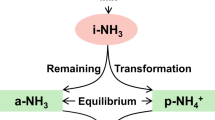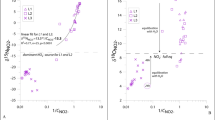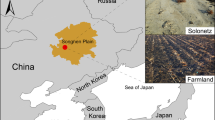Abstract
Investigating the sources of ammonia (NH3) in the atmosphere and the contribution of each source is essential for environmental pollution control. The presented dataset aims to provide 15N natural abundance (δ15N) data collected from different controlled treatments to fill the knowledge gap between insufficient data of soil δ15N-NH3 and accurately identifying atmospheric NH3 source apportionments. Our results showed that the overall δ15N-NH3 values emitted from soil ranged from −46.09 to 10.22‰, with an average of −26.81 ± 11.17‰. The mean δ15N-NH3 values under different nitrogen (N) application rates, N fertilizer types, air temperatures, soil moisture, soil pH, soil types, and land use types were −29.41 ± 10.91, −32.43 ± 6.86, −29.10 ± 10.04, −30.31 ± 6.18, −24.84 ± 13.76, −23.53 ± 7.66, and −14.57 ± 12.54‰, respectively. Significant correlations were observed between δ15N-NH3 values and soil pH, soil NO3−-N concentration, and NH3 volatilization. This unique database provides basic data and evidence for the qualification of atmospheric NH3 source apportionments under different study area conditions.
Similar content being viewed by others
Background & Summary
Food security and air quality are two major issues that currently exist and will persist for a long time, with complex causal relationships that need to be balanced1,2,3. Excessive nitrogen (N) input increased crop yields while resulted in significant losses of reactive N, particularly ammonia (NH3) emissions, which have gradually become a constraining factor affecting the balance4,5,6. Approximately 40% of total NH3 is emitted from N fertilizer application, which has resulted in air pollution, soil acidification, water eutrophication, and biodiversity loss7,8,9,10,11. Therefore, identifying and quantifying the contribution of N fertilizer application to atmospheric NH3 is vital in better understanding the pathways for NH3 emission reduction and determining mitigation options.
The use of 15N natural abundance (δ15N) technology is a complementary tool to identify and quantify the sources of atmospheric NH3 owing to its relatively distinct and well-defined N isotopic signature12,13,14,15,16. Previous studies have found that the δ15N values of NH3 emitted from agricultural sources, such as volatilized fertilizer (−46 ± 5‰) and livestock (−28 ± 11‰), were considerably lower than those emitted from fossil fuel sources (−8 ± 6‰), marine emissions (−10 ± 3‰) and other sources, as reported by Elliott, et al.17 and Bhattarai, et al.18. Therefore, according to the distinct signature of δ15N-NH3 values, the contribution of soil NH3 emissions to atmospheric NH3 can successfully be quantified at present18,19,20. For instance, through the observation of δ15N-NH3 values from major local emissions, the combined contribution of cropland and livestock was found to account for 64.5% of the total NH3 emissions in the Beijing-Tianjin-Hebei region20.
Some studies have investigated δ15N-NH3 values emitted from agricultural sources, but most of them used fixed isotope values to quantify the contribution of cropland volatilization to atmospheric NH3. However, source identification requires knowledge of study area conditions and source emission characteristics. NH3 volatilization is influenced by various factors such as fertilizer application rate, soil NH4+ concentration, and temperature21,22,23,24. These factors directly or indirectly lead to large changes in the δ15N value of NH3 volatilization25,26,27. For instance, temperature is negatively correlated with the δ15N-NH3 value according to field observations19. Moreover, Cejudo and Schiff28 stated that the higher the water pH, the easier the volatilization of 14N, resulting in a lower volatilized δ15N value. Many factors influence the δ15N-NH3 value in the volatilization process of soil NH3, and certain changes can be expected in the temporal or spatial scales. Therefore, the characteristics of δ15N-NH3 values must be studied under different conditions as the use of fixed coefficients may affect the accuracy of traceability results29.
Owing to the complexity of the influencing factors, there is an urgent need to precisely analyze the influence of various factors on δ15N-NH3 values to provide a research basis for subsequent traceability studies. To fill this knowledge gap, we established a comprehensive database on δ15N-NH3 values from soils controlled by seven factors. This database is available from the Figshare repository. The results in this database provided basic data of δ15N-NH3 values for the entire volatilization process in soils and improved the accuracy of the traceability analysis of atmospheric NH3.
Methods
Experiment design
To investigate the δ15N values of soil NH3 volatilization under different conditions, seven controlled laboratory incubation experiments were conducted using the sponge-trapping method. The experiments included fertilization factors (N application rate, and N fertilizer type), meteorological factors (air temperature), soil factors (soil moisture, soil pH, and soil type), and land use type. The detailed experimental design is presented in Table 1.
Experimental materials
Soil samples were collected from the surface layer of the soil (0–20 cm). Soils of Exp1, 2, and 4 were collected in mid-November 2018 and those of Exp 3 and 5 were collected in mid-November 2019 from Changshu Agro-ecological Experimental Station (31° 32′ 93″ N, 120° 41′ 88″ E), Jiangsu province in eastern China. Soils of Exp6 were collected with the same topography, fertilization, tillage practices, and crop growth conditions, from early September to mid-October 2020 from Beipiao, Liaoning province in northeastern China (41° 57′ N, 120° 36′ E), Xinxiang, Henan province in central China (35° 60′ N, 113° 56′ E), Tangshan, Hebei province in northern China (39° 47′ N, 118° 0′ E), and Linzhi, Tibet in the highlands of southwestern China (29° 34′ N, 94° 25′ E), respectively. Soils of the bamboo forest in Exp7 were collected at Nanjing, Jiangsu province (31° 16′ N, 118° 53′ E), whereas those of vineyard and vegetable growth were collected from Changshu Agro-ecological Experimental Station, Jiangsu province (31° 32′ 93″ N, 120° 41′ 88″ E). Roots and visible rocks in the soil were carefully removed manually, and the soil sample was then air-dried and ground to pass through a 2-mm stainless steel sieve to achieve a high degree of homogeneity. The physicochemical properties of the different sets of soils are listed in Table 2. The δ15N values of urea, compound fertilizer, and ammonium nitrate phosphate fertilizer were −3.6 ± 0.1, −3.0 ± 0.4, and −0.8 ± 0.7‰, respectively.
Soil physical and chemical analysis
The concentrations of soil NH4+-N and NO3−-N were determined using a continuous-flow analyzer (Skalar San++ System, Breda, Netherlands) after filtering, the addition of 5 g of post-culture soil to 50 mL of 2 mol L−1 KCl solution and shaking for 1 h. The minimum detection limits for the NH4+-N and NO3−-N concentrations were 0.046 and 0.015 mg N L−1, respectively. Subsequently, soil was removed from the culture bottles to dry in natural air. The soil texture was assessed using the laser diffraction method, soil pH was measured using a glass electrode in a soil: water suspension at 1:2.5(v/v), and soil total nitrogen (TN) content was determined using a Vario Max CN analyzer (Elementar, Vario Max CN, Hanau, Germany) through the dry burning method.
NH3 volatilization measurements
In this study, the sponge-trapping method described by Ti, et al.30 was employed to measure NH3 volatilization under different influencing factors in controlled laboratory incubation experiments. In particular, the NH3 emitted from soil was absorbed in a sponge with an acid solution for staged cultivation. To capture NH3 emissions from the soil, a sponge with a diameter and thickness of 8.5 and 1 cm, respectively, containing 4 mL of glycerol phosphate absorbent was positioned on the neck of a 500-mL incubation bottle. The bottle cap featured a hole with a diameter of 1.4 cm, into which a rubber tube with a diameter of 1.2 cm was inserted. A small sponge with absorbent was placed in this hole to prevent the loss of NH3 from the bottle into the air (Fig. 1).
The experiment, designed for non-destructive sampling with three replicates, ensured data accuracy. Dry-weight soil was placed in an incubation bottle, and soil moisture was adjusted to a specific percentage of WFPS or SWC by adding deionized water. The specific incubation conditions for the seven sets of experiments are listed in Table 2. Trapping sponges and incubated soils were sampled on days 1, 2, 3, 4, 5, 6, 7, and 15 (excluding day 7 for experiment Exp6). At each sampling interval, the removed trapping sponges were plunged into 50 mL of 1 mol L−1 KCl, shaken for 2.5 h at 100 rotations per minute for NH4+-N sample extraction, and analyzed for NH4+-N using a continuous-flow analyzer.
N isotopic analysis
The δ15N-NH3 values were measured using the method described by Liu, et al.31. This method relies on the isotopic analysis of nitrous oxide (N2O). By examining the linear correlation between the δ15N values of the substrate (NH4+) and resulting gas (N2O), a standard curve was fitted, enabling the deduction of the δ15N-NH4+ values of the substrate. The isotope ratio is reported in parts per thousand relative to atmospheric N2 according to Eq. (1).
The N isotopic compositions of all the samples were analyzed using an isotope mass spectrometer (Isoprime 100, Isoprime, UK). International reference δ15N-NH4+ standards, namely, USGS25 (−30.4‰), USGS26 (+53.7‰), and IAEAN1 (+0.4‰), were chosen for data correction purposes.
Data Records
The dataset is available at Figshare32, an open-access repository where users can make all their research outputs available in a citable, shareable, and discoverable manner. The Excel file was named Natural Isotopic Abundance of Soil Ammonia Volatilization Excel Data.xlsx. This file provided complete information on the seven controlled experiments, including experiment sets (array named Set), days of incubation (array named Day), experimental treatment (array named Treatment), the mean values of δ15N-NH3, cumulative NH3, soil NH4+-N, soil NO3−-N, soil pH, and their standard deviations (array named sd). The data for Exp1, Exp2, Exp6, and Exp7 have been published and were described in detail29,30,33,34.
Technical Validation
The data were collected and measured using a standardized protocol and calibrated continuous-flow analyzer and an isotope mass spectrometer. Each experiment was repeated thrice to ensure the accuracy of the results. The data were analyzed using appropriate statistical methods to identify the significant effects of the different factors on δ15N-NH3 values emitted from soils.
Usage Notes
This dataset provides a valuable resource for researchers and policymakers, as well as those who are interested in agricultural sources of atmospheric NH3 and effective strategies to reduce NH3 emissions and protect the environment. This dataset can also be used to validate the “bottom-up” emission inventory methodology and model simulations.
Code availability
No custom code was used for the curation and/or validation of the dataset.
References
Ma, R. et al. Mitigation potential of global ammonia emissions and related health impacts in the trade network. Nat. Commun. 12, 6308, https://doi.org/10.1038/s41467-021-25854-3 (2021).
Kang, J. et al. Ammonia mitigation campaign with smallholder farmers improves air quality while ensuring high cereal production. Nat. Food 4, 751–761, https://doi.org/10.1038/s43016-023-00833-7 (2023).
Guo, Y. et al. Air quality, nitrogen use efficiency and food security in China are improved by cost-effective agricultural nitrogen management. Nat. Food 1, 648–658, https://doi.org/10.1038/s43016-020-00162-z (2020).
Shen, H. et al. Intense Warming Will Significantly Increase Cropland Ammonia Volatilization Threatening Food Security and Ecosystem Health. One Earth 3, 126–134, https://doi.org/10.1016/j.oneear.2020.06.015 (2020).
Yao, Y. et al. Urea deep placement for minimizing NH3 loss in an intensive rice cropping system. Field Crops Res. 218, 254–266, https://doi.org/10.1016/j.fcr.2017.03.013 (2018).
Hartmann, T. E. et al. Yield and N use efficiency of a maize–wheat cropping system as affected by different fertilizer management strategies in a farmer’s field of the North China Plain. Field Crops Res. 174, 30–39, https://doi.org/10.1016/j.fcr.2015.01.006 (2015).
Paulot, F. et al. Ammonia emissions in the United States, European Union, and China derived by high‐resolution inversion of ammonium wet deposition data: Interpretation with a new agricultural emissions inventory (MASAGE_NH3). J. Geophys. Res.: Atmos. 119, 4343–4364, https://doi.org/10.1002/2013jd021130 (2014).
Kang, Y. et al. High-resolution ammonia emissions inventories in China from 1980 to 2012. Atmos. Chem. Phys. 16, 2043–2058, https://doi.org/10.5194/acp-16-2043-2016 (2016).
Li, B. et al. Improved gridded ammonia emission inventory in China. Atmos. Chem. Phys. 21, 15883–15900, https://doi.org/10.5194/acp-21-15883-2021 (2021).
An, Z. et al. Severe haze in northern China: A synergy of anthropogenic emissions and atmospheric processes. Proc. Natl. Acad. Sci. USA. 116, 8657–8666, https://doi.org/10.1073/pnas.1900125116 (2019).
Shen, W. et al. Opportunity and shift of nitrogen use in China. Geogr. Sustain. 5, 33–40, https://doi.org/10.1016/j.geosus.2023.09.003 (2024).
Robinson, D. δ15N as an integrator of the nitrogen cycle. Trends Ecol. Evol. 16, 153–162 (2001).
Heaton, T. H. E. Isotopic studies of nitrogen pollution in the hydrosphere and atmosphere: a review. Chem. Geol. 59, 87–102 (1986).
Freyer, H. D. & Aly, A. I. M. Nitrogen-15 Variations in Fertilizer Nitrogen. J. Environ. Qual. 3, 405–406, https://doi.org/10.2134/jeq1974.00472425000300040023x (1974).
Choi, W. J. et al. Synthetic fertilizer and livestock manure differently affect δ15N in the agricultural landscape: A review. Agric., Ecosyst. Environ. 237, 1–15, https://doi.org/10.1016/j.agee.2016.12.020 (2017).
Zhang, Y. et al. Source Apportionment of Atmospheric Ammonia at 16 Sites in China Using a Bayesian Isotope Mixing Model Based on δ15N-NHx Signatures. Environ. Sci. Technol. 57, 6599–6608, https://doi.org/10.1021/acs.est.2c09796 (2023).
Elliott, E. M., Yu, Z., Cole, A. S. & Coughlin, J. G. Isotopic advances in understanding reactive nitrogen deposition and atmospheric processing. Sci. Total Environ. 662, 393–403, https://doi.org/10.1016/j.scitotenv.2018.12.177 (2019).
Bhattarai, N. et al. δ15N-stable isotope analysis of NHx: An overview on analytical measurements, source sampling and its source apportionment. Front. Environ. Sci. Eng. 15, 126, https://doi.org/10.1007/s11783-021-1414-6 (2021).
Ti, C. et al. Isotopic characterization of NHx-N in deposition and major emission sources. Biogeochemistry 138, 85–102, https://doi.org/10.1007/s10533-018-0432-3 (2018).
Peng, L. et al. Traceability of atmospheric ammonia in a suburban area of the Beijing-Tianjin-Hebei region. Sci. Total Environ. 907, 167935, https://doi.org/10.1016/j.scitotenv.2023.167935 (2024).
Ma, R. et al. Global soil‐derived ammonia emissions from agricultural nitrogen fertilizer application: A refinement based on regional and crop‐specific emission factors. Global Change Biol. 27, 855–867, https://doi.org/10.1111/gcb.15437 (2020).
Xu, R. et al. Global ammonia emissions from synthetic nitrogen fertilizer applications in agricultural systems: Empirical and process-based estimates and uncertainty. Glob Chang Biol. 25, 314–326, https://doi.org/10.1111/gcb.14499 (2019).
Pan, B., Lam, S. K., Mosier, A., Luo, Y. & Chen, D. Ammonia volatilization from synthetic fertilizers and its mitigation strategies: A global synthesis. Agric., Ecosyst. Environ. 232, 283–289, https://doi.org/10.1016/j.agee.2016.08.019 (2016).
Turner, D. A., Edis, R. E., Chen, D., Freney, J. R. & Denmead, O. T. Ammonia volatilization from nitrogen fertilizers applied to cereals in two cropping areas of southern Australia. Nutr. Cycling Agroecosyst. 93, 113–126, https://doi.org/10.1007/s10705-012-9504-2 (2012).
Huang, S. et al. Seasonal pattern of ammonium 15N natural abundance in precipitation at a rural forested site and implications for NH3 source partitioning. Environ. Pollut. 247, 541–549, https://doi.org/10.1016/j.envpol.2019.01.023 (2019).
Felix, J. D., Elliott, E. M., Gish, T. J., McConnell, L. L. & Shaw, S. L. Characterizing the isotopic composition of atmospheric ammonia emission sources using passive samplers and a combined oxidation-bacterial denitrifier approach. Rapid Commun. Mass Spectrom. 27, 2239–2246, https://doi.org/10.1002/rcm.6679 (2013).
Wells, N. S., Baisden, W. T. & Clough, T. J. Ammonia volatilisation is not the dominant factor in determining the soil nitrate isotopic composition of pasture systems. Agric., Ecosyst. Environ. 199, 290–300, https://doi.org/10.1016/j.agee.2014.10.001 (2015).
Cejudo, E. & Schiff, S. L. Nitrogen isotope fractionation factors (α) measured and estimated from the volatilisation of ammonia from water at pH 9.2 and pH 8.5. Isot. Environ. Health Stud. 54, 642–655, https://doi.org/10.1080/10256016.2018.1526792 (2018).
Bai, X. et al. Natural abundance of a volatile nitrogen isotope of ammonia under different land uses. J. Agro-Environ. Sci. 41, 1590–1597, https://doi.org/10.11654/jaes.2022-0016 (2022).
Ti, C. et al. Changes of δ15N values during the volatilization process after applying urea on soil. Environ. Pollut. 270, 116204, https://doi.org/10.1016/j.envpol.2020.116204 (2021).
Liu, D., Fang, Y., Tu, Y. & Pan, Y. Chemical method for nitrogen isotopic analysis of ammonium at natural abundance. Anal. Chem. 86, 3787–3792, https://doi.org/10.1021/ac403756u (2014).
Peng, L. et al. Natural Isotopic Abundance of Soil Ammonia Volatilization Excel Data. figshare https://doi.org/10.6084/m9.figshare.27117486 (2024).
Peng, L. et al. 15N natural abundance characteristics of ammonia volatilization from soils applied by different types of fertilizer. Atmosphere 13, 1566, https://doi.org/10.3390/atmos13101566 (2022).
Li, M. et al. Changes of δ15N Values during Ammonia Volatilization from Different Upland Soils in China. Acta Pedol. Sin. 60, 705–715, https://doi.org/10.11766/trxb202110190563 (2023).
Acknowledgements
This work was supported by the National Key Research and Development Program of China (2023YFC3707402) and the National Natural Science Foundation of China (42177313 and 42061124001).
Author information
Authors and Affiliations
Contributions
Lingyun Peng: Data curation, Formal analysis, Writing-original draft preparation, Writing-review and editing. Chaopu Ti: Conceptualization, Methodology, Writing—review and editing. Bin Yin: Conceptualization. Xiao Bai: Data curation. Miao Li: Data curation. Limin Tao: Data curation. Xiaoyuan Yan: Conceptualization, Supervision, Writing—review and editing.
Corresponding author
Ethics declarations
Competing interests
The authors declare no competing interests.
Additional information
Publisher’s note Springer Nature remains neutral with regard to jurisdictional claims in published maps and institutional affiliations.
Rights and permissions
Open Access This article is licensed under a Creative Commons Attribution 4.0 International License, which permits use, sharing, adaptation, distribution and reproduction in any medium or format, as long as you give appropriate credit to the original author(s) and the source, provide a link to the Creative Commons licence, and indicate if changes were made. The images or other third party material in this article are included in the article’s Creative Commons licence, unless indicated otherwise in a credit line to the material. If material is not included in the article’s Creative Commons licence and your intended use is not permitted by statutory regulation or exceeds the permitted use, you will need to obtain permission directly from the copyright holder. To view a copy of this licence, visit http://creativecommons.org/licenses/by/4.0/.
About this article
Cite this article
Peng, L., Ti, C., Yin, B. et al. A dataset for 15N natural abundance of soil ammonia volatilization. Sci Data 11, 1351 (2024). https://doi.org/10.1038/s41597-024-04216-w
Received:
Accepted:
Published:
DOI: https://doi.org/10.1038/s41597-024-04216-w




